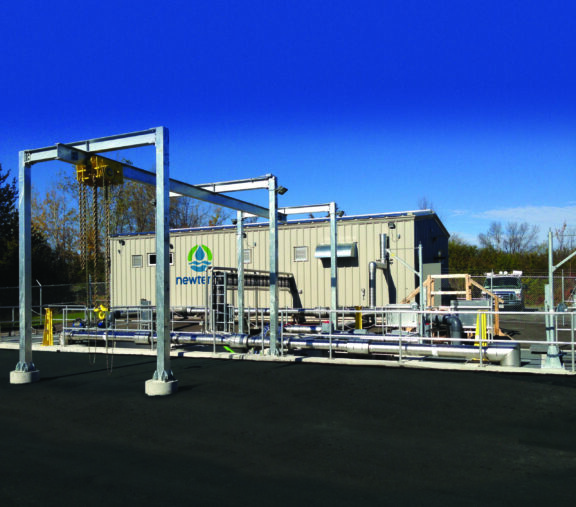
Argos Sequencing Batch Reactor
The Newterra Argos Sequencing Batch Reactor (SBR) is a True Batch SBR system powered by the Triton 2.0 Process Aerator.
Read More about Argos Sequencing Batch ReactorThe Newterra Clear3 prefabricated, pre-engineered, pre-tested Membrane Bioreactor (MBR) systems employ the industry benchmark—Veolia ZeeWeed membranes. With guaranteed delivery to meet your ship, barge or ice road schedules, the standardized modular designs and complete range of system types and sizes are reuse ready to meet or exceed local discharge requirements. Newterra has been providing remote camps with quality Modular MBR.WWT Sewage and Potable Water Systems from the high Arctic to the high plateaus of Chile to the middle of Africa.

The Clear3 MBR.WWT Modular Wastewater Systems for stringent discharge limits or footprint concerns. These MBR Sewage Systems offer optional sludge treatment modules and modules for strict phosphorous and/or nitrogen limits. You have options for reuse for camp toilet flushing, dust suppression, and ice roads, and these MBRs include inlet screening and equalization where required. The Clear3 MBR.WWT Potable Remote Systems tackle any water source from well, river, lake, brackish, and seawater sources and offer water safe systems for military camps and installations.
newtN SCADA: Systems feature sophisticated controls and advanced telemetry for 24/7 monitoring, diagnostics and control from anywhere
Sludge: We offer integrated sludge dewatering; filter cakes are suitable for incineration, landfill or use as fertilizer
Scalable: Our modular systems can expand as capacity requirements change – and be redeployed at the end of a temporary project if necessary. Developers can defer infrastructure spending by phasing in sewage treatment capacity in parallel with the phases of a project
Reduced Onsite Construction: Modular systems are pre-plumbed, pre-wired and undergo comprehensive testing, allowing for fast installation and minimized onsite work
Maximum Uptime: Proven, standardized components and strategic redundancy to allow continuous operation – even during maintenance procedures
Minimal Maintenance: Air scouring and periodic membrane relaxation prevent fouling; chemical cleaning is reduced over hollow fiber membranes
Operator-Friendly: Our ground-level module removal system is good example of the design considerations we incorporate for easy servicing and improved safety

We understand your unique challenges. Beyond a technology solution, Newterra is dedicated to the entire lifecycle of your needs. Whatever support you need, Newterra probably has a solution to solve it..
Whether your needs are short-term bridge, emergency or supplemental or long-term system deployment, Newterra has flexible solutions that alleviate the need for major capital expenditure.
From operations consultation and long-term service contracts embowered by our Internet of Things (IoT) platform to commissioning expertise and emergency ad-hoc needs almost anywhere in the world, our technical experts are available to serve you. Let Newterra keep your systems optimized.
From licensed and certified removal, to exchange, to supply, Newterra provides the gamut of services to keep your media and membrane solutions at peak performance. Let the same experts who build your systems help you keep them running.
Rely on Newterra for all your aftermarket needs. Our teams have the background and tools to serve you effectively. Nothing beats original equipment manufacturer (OEM) service. Anything you need, we’re here for you.
The Clear3 MBR.WWT technology addresses a wide range of wastewater treatment applications requiring high-quality effluent to meet regulatory requirements or reuse. It targets Biological Oxygen Demand (BOD), Total Suspended Solids (TSS), Bacteria, Total Coliforms, Ammonia, Nitrogen, and Phosphorus.
These MBR Systems also eliminate many pharmaceuticals from the waste stream, a growing concern for natural habitats and drinking water. With extensive experience with groundwater remediation, Newterra brings solutions for emerging contaminant challenges such as Perfluoroalkyl and polyfluoroalkyl substances (PFAS) and other compounds that may be present in the system effluent.
| Biological Oxygen Demand (BOD) | <5.0 mg/L |
| Total Suspended Solids (TSS) | <5.0 mg/L |
| Ammonia-N | <1.0 mg/L |
| Turbidity | <0.2 NTU |
| Total Phosphorus | <0.05 mg/L* |
| Total Nitrogen | <3.0 mg/L* |
Enhanced nutrient removal design can achieve lower effluent results:
| Total Phosphorus | <0.05 mg/L |
| Total Nitrogen | <3.0 mg/L |
The ultimate process configuration is highly dependent on the following:

The Newterra Argos Sequencing Batch Reactor (SBR) is a True Batch SBR system powered by the Triton 2.0 Process Aerator.
Read More about Argos Sequencing Batch Reactor
Custom, Scalable, and Prefabricated, Newterra Clear3 MBR.MF Custom Modular Membrane Bioreactor Facilities
Read More about Clear³ MBR.MF Custom Modular Membrane Bioreactor Facilities
Newterra Clear³ MBR.ST Configurable Membrane Bioreactor Decentralized Systems are custom configured for your site with the Clear³ standard treatment modules and either in-ground or above-ground tankage.
Read More about Clear³ MBR.ST Configurable Membrane Bioreactor Decentralized Systems
The Newterra Tri-Oval Oxidation Ditch System is a subsurface complete mix, looped reactor system that is ideal for municipal and industrial wastewater treatment facilities.
Read More about Tri-Oval Oxidation Ditch System
Newterra UniSystem Package Wastewater Treatment Plant With installations around the world, Newterra’s High-Rate Activated Sludge (HRAS) and Extended Aeration packaged plant is a gold standard for reliability.
Read More about UniSystem Package Wastewater Treatment Plant